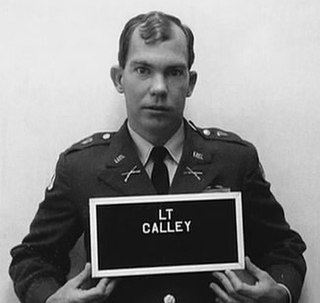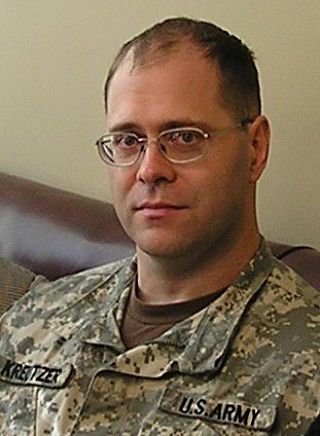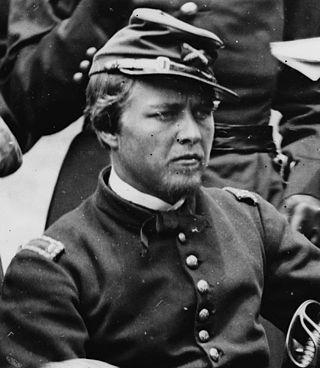In United States law, an Alford plea, also called a Kennedy plea in West Virginia, an Alford guilty plea, and the Alford doctrine, is a guilty plea in criminal court, whereby a defendant in a criminal case does not admit to the criminal act and asserts innocence, even if the evidence presented by the prosecution would be likely to persuade a judge or jury to find the defendant guilty beyond a reasonable doubt. This can be caused by circumstantial evidence and testimony favoring the prosecution and difficulty finding evidence and witnesses that would aid the defense.
A court-martial or court martial is a military court or a trial conducted in such a court. A court-martial is empowered to determine the guilt of members of the armed forces subject to military law, and, if the defendant is found guilty, to decide upon punishment. In addition, courts-martial may be used to try prisoners of war for war crimes. The Geneva Conventions require that POWs who are on trial for war crimes be subject to the same procedures as would be the holding military's own forces. Finally, courts-martial can be convened for other purposes, such as dealing with violations of martial law, and can involve civilian defendants.

William Laws Calley Jr. is a former United States Army officer who was convicted by court-martial for the murder of 22 unarmed South Vietnamese civilians in the My Lai massacre on March 16, 1968, during the Vietnam War. Calley was released to house arrest under orders by President Richard Nixon three days after his conviction. A new trial was ordered by the United States Court of Appeals for the Fifth Circuit but that ruling was overturned by the Supreme Court. Calley served three years of house arrest for the murders. Public opinion at the time about Calley was divided. Since his dismissal from the U.S. Army and release from prison, Calley has avoided public attention.

The United States Disciplinary Barracks (USDB), colloquially known as Leavenworth, is a military correctional facility located on Fort Leavenworth, a United States Army post in Kansas.
Capital murder refers to a category of murder in some parts of the US for which the perpetrator is eligible for the death penalty. In its original sense, capital murder was a statutory offence of aggravated murder in Great Britain, Northern Ireland, and the Republic of Ireland, which was later adopted as a legal provision to define certain forms of aggravated murder in the United States. Some jurisdictions that provide for death as a possible punishment for murder, such as California, do not have a specific statute creating or defining a crime known as capital murder; instead, death is one of the possible sentences for certain kinds of murder. In these cases, "capital murder" is not a phrase used in the legal system but may still be used by others such as the media.

The use of capital punishment by the United States military is a legal punishment in martial criminal justice. Despite its legality, capital punishment has not been imposed by the U.S. military in over sixty years.

William J. Kreutzer Jr. is a former United States Army soldier who was convicted of killing one officer and wounding 18 other soldiers when he opened fire on a physical training formation on October 27, 1995, at Fort Bragg, North Carolina. Kreutzer was sentenced to death, but his sentence was later commuted to life in prison by the Army Court of Criminal Appeals in connection with concerns regarding mental illness.

Peter Conover Hains was a major general in the United States Army, and a veteran of the American Civil War, Spanish–American War, and the First World War. He is best known for his engineering efforts, such as the creation of the Tidal Basin in Washington, D.C., and for laying out the Panama Canal.
The Kansas City crime family, also known as the Civella crime family or Kansas City Mafia, is an Italian-American Mafia family based in Kansas City, Missouri.

Thornton Jenkins Hains (1866-1953) was an American sea novelist best known today for his role in the murder of William Annis. Hains later used the pen name Mayn Clew Garnett.
The Double Jeopardy Clause of the Fifth Amendment to the United States Constitution provides: "[N]or shall any person be subject for the same offence to be twice put in jeopardy of life or limb..." The four essential protections included are prohibitions against, for the same offense:
The Nancy Kissel murder case was a highly publicised criminal trial held in the High Court of Hong Kong, where American expatriate Nancy Ann Kissel was convicted of the murder of her husband, 40-year-old investment banker Robert Peter Kissel, in their apartment on 2 November 2003. It was arguably the highest profile criminal case involving an expatriate in Hong Kong's history, and was closely covered in the media.

Peter Conover Hains III was an American Army cavalry officer and major general who competed in the 1928 Olympic games in the modern pentathlon. Hains graduated from West Point in 1924, where he ranked 162nd in his class. Hains' family had a long legacy of military service, with his great grandfather, grandfather, and uncle all serving as high-ranking military officers. Hains' father Peter Hains was involved in an infamous murder scandal in New York City in 1909.

The Maywand District murders were the thrill killings of at least three Afghan civilians perpetrated by a group of U.S. Army soldiers from January to May 2010, during the War in Afghanistan. The soldiers, who referred to themselves as the "Kill Team", were members of the 3rd Platoon, Bravo Company, 2nd Battalion, 1st Infantry Regiment, and 5th Brigade, 2nd Infantry Division. They were based at FOB Ramrod in Maiwand, from Kandahar Province of Afghanistan.
Akai Gurley, a 28-year-old black man, was fatally shot on November 20, 2014, in Brooklyn, New York City, United States, by a New York City Police Department officer. Two police officers, patrolling stairwells in the New York City Housing Authority (NYCHA)'s Louis H. Pink Houses in East New York, Brooklyn, entered a pitch-dark, unlit stairwell. Officer Peter Liang, 27, had his firearm drawn. Gurley and his girlfriend entered the seventh-floor stairwell, fourteen steps below them. Liang fired his weapon; the shot ricocheted off a wall and fatally struck Gurley in the chest. A jury convicted Liang of manslaughter, which a court later reduced to criminally negligent homicide.

Derek Michael Chauvin is an American former police officer who was convicted of murdering George Floyd, a 46-year-old African-American man, in Minneapolis, Minnesota. Chauvin was a member of the Minneapolis Police Department from 2001 to 2020.
On 4 June 2017, United States Army Special Forces soldier Staff Sergeant Logan Melgar was found dead as a result of asphyxiation in the American embassy in Mali's on-site housing, which he shared with other members of United States special operations forces. The incident has been described as either result of a "hazing" or to cover up other crimes committed by the perpetrators.










